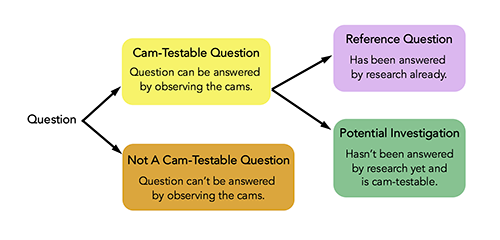What Kinds of Questions Can We Investigate?
Watching the Bird Cams can generate all kinds of questions. Some questions may have answers already based on past research. Other questions may not have answers yet—but could be answered by collecting and analyzing data from the cams. It’s those questions we hope to identify for potential investigations.
As you encounter questions, try categorizing each one:
- Cam-Testable Question: Could this question be answered using footage observable from the cams? If so, we can call it a “Cam-Testable Question” and consider it for an investigation, as long as it hasn’t already been answered by past research.
- Reference Question: Has it been answered by past research already? Some cam-testable questions are already well-documented in the scientific literature. If so, let’s categorize it as a “Reference Question” and share information about the answer. If we’re satisfied with that answer, we won’t need to investigate this question.
- Not a Cam-Testable Question: If the question can’t be answered using footage from the cams, it might be possible to answer it using other research methods, such as collecting data from other sources or conducting experiments. However, since our project is limited to using cam footage, we will categorize it as “Not A Cam-Testable Question” if we can’t answer it by observing the cams.

Figure 1: Use this testable question flowchart to help categorize different questions.
Guess Which Category: Reference Question, Cam-Testable Question, or Not Cam-Testable Question? Three Examples.
1. How many eggs do Red-tailed Hawks usually lay?
Did you categorize this as a reference question? You’re right–while we can observe the number of eggs in the nest with the camera, this question has been documented in the scientific literature by scientists who have monitored Red-tailed Hawk nests, finding that they typically lay between 1 and 5 eggs per clutch.
2. How much does the diet vary at the Cornell hawks’ nest from year to year?
Did you categorize this as a cam-testable question that has potential for investigation? Right. In fact, viewers at the Red-tailed Hawk answered this question by identifying each prey item brought to the nest, in each of four years. They found that the composition of eight prey categories did change from year to year. For example, chipmunks accounted for about 49% of all prey items delivered in 2012 compared with 24% in 2013, 51% in 2014, and 30% in 2015.
3. Why do Red-tailed Hawks use green boughs in their nests?
Did you categorize this as a question that is not testable for a study using cam footage? We agree. Some past studies have hypothesized that greenery may provide insulation or that evergreen boughs include natural chemicals that could repel pests. We’re not aware of a definitive answer yet, but testing these ideas would not be possible just by observing cams, since we cannot gather information about thermal properties at the nest or experiment to see if there is a connection between pests and natural chemicals in the boughs.
Great! Now once you’ve identified some cam-testable questions, read our next post about how to choose or refine one for investigation.